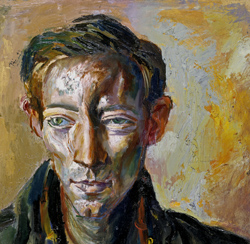Conservation Department
Painting Conservation
introduction | essay | objects | paintings | paper | prevention | textiles
 detail: Albert Tucker, 'Martin Smith' 1946, oil on composition board,
Collection of the National Gallery
detail: Albert Tucker, 'Martin Smith' 1946, oil on composition board,
Collection of the National Gallerymore detail
Paintings Conservators at the National Gallery of Australia are responsible for ensuring that paintings and frames held in the International and the Australian Art Collections are kept in a stable condition and remain accessible for display. Conservation treatments carried out in the paintings laboratory fall into the following categories: stabilisation, repair, cleaning and restoration. Major treatments can include all four activities.
Stabilisation and repair involve treatments which allow a painting to be safely handled and moved or which facilitate further conservation treatment. Consolidation of lifting cracks or flaking paint, tear repairs, lining and edge lining may be executed as discrete treatments or as a preliminary to cleaning and/or restoration. Correct stretching is crucial to the longevity of paintings on stretched canvas and in the day to day work of the paintings conservation section, many treatments involve structural issues concerning the support offered by stretcher or strainer to a canvas.
Cleaning procedures include surface cleaning, which removes dust, dirt and accreted material from the paint surface using a variety of dry and wet methods, as well as varnish removal. The removal of old varnish can often reveal fresh, bright colour which has been hidden for years under a discoloured or damaged surface coating. Restoration processes include infilling sites of paint losses and retouching the filled areas to restore pictorial coherence. Scientific analysis is often undertaken to identify materials to be treated and to illuminate artist technique.
Conservators also offer advice on packing and transport for many of the paintings which travel to other institutions for exhibition. For example, in 1998, Blue Poles was treated for travel to New York and London for the Jackson Pollock retrospective.
related articles
Discovering a Grace Crowley painting artonview Summer 48 2006 pp28-29
A problem with purity: John Peter Russell's 'Vue d'Antibes' artonview 6 winter 1996 pp14-16
Enzo Cucchi's 'Il vento dei galli neri', Allan Byrne artonview 20 Summer 1999-2000 pp47-49
George Lambert’s The old dress, Kim Brunoro
Portrait of Abel Tasman, his wife and daughter Allan Byrne artonview 22 winter 2000 pp32-35
Treatment of John Glover’s Mount Wellington and Hobart Town from Kangaroo Pointartonview 34 winter 2003pp27-31
Twilight of the west: contemporary solutions for some contemporary problems Erica Burgess artonview 1 autumn 1995 pp52-53
links
X-RAYS: electromagnetic radiation of short wavelength able to pass through opaque bodies
preventative conservation
Why paintings deteriorate
